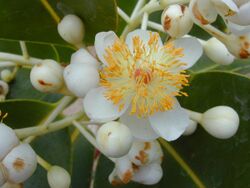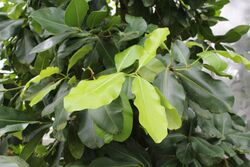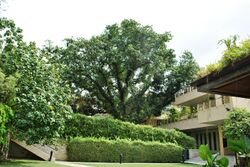Biology:Calophyllum inophyllum
| Calophyllum inophyllum | |
|---|---|

| |
| Scientific classification | |
| Kingdom: | Plantae |
| Clade: | Tracheophytes |
| Clade: | Angiosperms |
| Clade: | Eudicots |
| Clade: | Rosids |
| Order: | Malpighiales |
| Family: | Calophyllaceae |
| Genus: | Calophyllum |
| Species: | C. inophyllum
|
| Binomial name | |
| Calophyllum inophyllum | |
| Synonyms[3] | |
|
List
| |
Calophyllum inophyllum is a large evergreen plant, commonly called tamanu, oil-nut, mastwood, beach calophyllum or beautyleaf.[2] It is native to tropical Asia and Wallacea. Due to its importance as a source of timber for the traditional shipbuilding of large outrigger ships, it has been spread in prehistoric times by the migrations of the Austronesian peoples to the islands of Oceania and Madagascar , along with other members of the genus Calophyllum. It has since been naturalized in regions in the East African coast.[4] It is also a source of the culturally important tamanu oil.
Names
Calophyllum inophyllum is also known as Alexandrian laurel[2][5] balltree,[2] beach touriga,[2] Borneo-mahogany,[2] Indian doomba oiltree,[2] Indian-laurel,[2] laurelwood,[2] red poon,[6] satin touriga,[2] and tacamahac-tree.[2] In Island Southeast Asia and Oceania, they are also commonly known as bintangur, bitaog, tamanu, or kamani.[7] In India it is known as Polanga (ପୋଲାଙ୍ଗ) in Odia, Punnag (पुन्नाग) in Marathi and Punnai in Tamil languages. In Kiswahili it is known as Mtondoo.[8] [9]
Description
Tree and leaves
Calophyllum inophyllum is a low-branching and slow-growing tree, it spreads with a broad and irregular crown. It usually reaches 8 to 30 m (26 to 98 ft) in height.[10] Its trunk is thick and covered with black and cracked bark.[11]
Flowers
Flowering can occur perennially, but usually two distinct flowering periods are observed twice a year, in late spring from April to June and in late autumn from October to December.[10] The flower is 25 to 30 mm (0.98 to 1.18 in) wide and occurs in racemose or paniculate inflorescences consisting of four to 15 flowers. It has a sweet fragrance which attracts many insects to pollinate it.[10]
Fruit
The fruit (the ballnut) is a round, green drupe measuring 2 to 4 cm (0.79 to 1.57 in) in diameter. When ripe, the fruit is wrinkled and its color varies from yellow to brownish-red. It has thin spongy flesh with a taste slightly like apple.[10][11]
Distribution and habitat
Calophyllum inophyllum is native to Africa in: Comoros; Kenya; Madagascar ; Mauritius; Mozambique; Seychelles; Tanzania (including Pemba Island of the Zanzibar Archipelago); south, southeast and east Asia in: Bangladesh;[12][13] Cambodia; China (on Hainan); southern India; Andaman and Nicobar Islands Indonesia; Japan (Ryukyu Islands)(Bonin Islands); Malaysia; Maldives; Myanmar; Papua New Guinea; the Philippines ; Sri Lanka; Taiwan; Thailand; Vietnam; the northwestern, southwestern and south central Pacific Region in: the Cook Islands; Fiji; French Polynesia (Marquesas and Society Islands); Guam; the Marshall Islands; Micronesia; the Northern Mariana Islands; Palau; and Samoa; and in Australia in: Northern Territory and Queensland.[2]
Now, it is widely cultivated in all tropical regions of the world.[2] Because of its decorative leaves, fragrant flowers, and spreading crown, it is best known as an ornamental plant.[2]
This tree often grows in coastal regions, as well as nearby lowland forests. However, it has also been cultivated successfully in inland areas at moderate altitudes. It tolerates varied kinds of soil, coastal sand, clay, or even degraded soil.[citation needed]
Uses
Shipbuilding
Mastwood is notable for its ability to grow to massive sizes in sandy or rocky beaches of island and coastal habitats, as well as its habit of sending out arching large trunks over the water where its seeds are dispersed via the currents.[14][4] Due to these characters, mastwood are of particular importance to traditional shipbuilding of the larger Austronesian outrigger ships and were carried with them as they migrated to Oceania and Madagascar. Other species of the genus Calophyllum were also used similarly, like Calophyllum soulattri, Calophyllum peekelii, and Calophyllum goniocarpum. They were comparable in importance to how oaks were in European shipbuilding and timber industries.[4]
Various parts of the mastwood were integral to the manufacture of outrigger canoes among various Austronesian peoples. The large curving limbs were commonly carved into the dugout canoe that formed the keel of the Austronesian outriggers ships. The strakes, which are attached to the keel by the uniquely Austronesian technique of "sewing" them with a combination of dowels and lashed lugs instead of nails, can also be made from mastwood, but it is more commonly made from other "softer" timber species like Artocarpus. Other pieces became masts, outrigger floats, and outrigger spars. Smaller curving limbs can also be carved into the ribs of the boat.[4]
In many parts of Polynesia, mastwood groves planted in marae were considered sacred and abodes of spirits. Mastwood were also carved into religious objects like tiki.[11][15] They are also commonly mentioned in the chants and folklore of Polynesia.[16]
In Australia , the 1889 book The Useful Native Plants of Australia records "During a debate on the Pearl Fisheries Bill in the Queensland Assembly, a clause was specially inserted to protect trees of this species at Thursday Island. A fine of £10 is inflicted on any person who cuts down or injures this or a cocoa-nut tree, or any other tree bearing edible fruit. This clause is, of course, in the interest of the aboriginals.".[17]
Other uses
Aside from shipbuilding, tamanu oil extracted from the fruit kernels were important in Polynesian culture. The oils, as well as poultices made from leaves and flowers, are also commonly used for traditional medicine.[14][11] The leaves contain compounds that are poisonous to fish and can be used as fish poison.[14] The sap of the tree is poisonous and is used to make poison arrows in Samoa.[18] The mature fruit is poisonous enough to use as rat bait.
The seeds yield a thick, dark green tamanu oil for medicinal use or hair grease.[19] The nuts are dried before cracking, after which the oil-laden kernel is removed and further dried. The first neoflavone isolated from natural sources (1951) was calophyllolide from C. inophyllum seeds.[20]
The Mavilan, a Tulu-speaking tribe in north Kerala in India, use the bark to make a powder that they mix with water and apply to plants affected by a type of plant disease caused by water that they call neeru vembu.[21]
The fatty acid methyl esters derived from C. inophyllum seed oil meets the major biodiesel requirements in the United States (ASTM D 6751), and European Union (EN 14214). The average oil yield is 11.7 kg-oil/tree or 4680 kg-oil/hectare. In the northwest coastal areas of Luzon island in Philippines, the oil was used for night lamps. This widespread use started to decline when kerosene became available, and later on electricity. It was also used as fuel to generate electricity to provide power for radios during World War II.
See also
References
- ↑ Barstow, M. (2019). "Calophyllum inophyllum". IUCN Red List of Threatened Species 2019: e.T33196A67775081. doi:10.2305/IUCN.UK.2019-1.RLTS.T33196A67775081.en. https://www.iucnredlist.org/species/33196/67775081. Retrieved 19 November 2021.
- ↑ 2.00 2.01 2.02 2.03 2.04 2.05 2.06 2.07 2.08 2.09 2.10 2.11 2.12 2.13 Calophyllum inophyllum was first described and published in Species Plantarum 1:513. 1753. {{citation | mode = cs1 | title = Calophyllum inophyllum | work = Germplasm Resources Information Network (GRIN) | url = | publisher = [[Organization:Agricultural Research ServAgricultural Research Service (ARS), United States Department of Agriculture (USDA) | access-date = 26 April 2012 }}
- ↑ "Calophyllum inophyllum L.". Royal Botanic Gardens, Kew. 2023. https://powo.science.kew.org/taxon/urn:lsid:ipni.org:names:427190-1#synonyms.
- ↑ 4.0 4.1 4.2 4.3 Damon, Frederick H. (2016). "A Story of Calophyllum: From Ecological to Social Facts". Trees, Knots, and Outriggers: Environmental Knowledge in the Northeast Kula Ring. Berghahn Books. pp. 180–246. ISBN 9781785332333. https://books.google.com/books?id=AObACwAAQBAJ&pg=PA180.
- ↑ Mabberley, D.J. (1997). The plant book: A portable dictionary of the vascular plants. Cambridge: Cambridge University Press. ISBN 9780521414210. https://archive.org/details/plantbookportabl00mabb.
- ↑ Kathirithamby-Wells, J. (2005). Nature and nation: Forests and Development in Peninsular Malaysia. University of Hawaii Press. p. xvi,34.
- ↑ Blust, Robert; Trussel, Stephen (2013). "The Austronesian Comparative Dictionary: A Work in Progress". Oceanic Linguistics 52 (2): 493–523. doi:10.1353/ol.2013.0016. https://www.researchgate.net/publication/265931196.
- ↑ https://en.bab.la/dictionary/swahili-english/mtondoo
- ↑ http://swahiliproverbs.afrst.illinois.edu/experience.html cf 1861
- ↑ 10.0 10.1 10.2 10.3 Tan, Ria (January 2013). "Penaga laut". http://www.wildsingapore.com/wildfacts/plants/coastal/calophyllum/inophyllum.htm.
- ↑ 11.0 11.1 11.2 11.3 Dweck, A.C.; Meadows, T. (2002). "Tamanu (Calophyllum inophyllum) – the African, Asian, Polynesian and Pacific Panacea". International Journal of Cosmetic Science 24 (6): 341–348. doi:10.1046/j.1467-2494.2002.00160.x. PMID 18494888. https://pinkhorizons.com/content/Tamanu.2.pdf. Retrieved 18 January 2019.
- ↑ "Calophyllum inophyllum". National Parks Singapore. https://www.nparks.gov.sg/florafaunaweb/flora/2/7/2774.
- ↑ "সুলতান চাঁপার নানা গুণ". http://www.prothom-alo.com/bangladesh/article/1314676/সুলতান-চাঁপার-নানা-গুণ.
- ↑ 14.0 14.1 14.2 Orwa, C.; Mutua, A.; Kindt, R.; Anthony, S. (2009). "Calophyllum inophyllum". Agroforestree Database:a tree reference and selection guide version 4.0. World Agroforestry. http://www.worldagroforestry.org/treedb/AFTPDFS/Calophyllum_inophyllum.PDF.
- ↑ Halpern, Georges M.; Weverka, Peter (2002). The Healing Trail: Essential Oils of Madagascar. Basic Health Publications, Inc.. pp. 43–50. ISBN 9781591200161. https://books.google.com/books?id=595byAiZLygC&pg=PA43.
- ↑ Allen, James A. (2002). "Calophyllum inophyllum". in Vozzo, J.A.. Tropical Tree Seed Manual. Agriculture Handbook. 721. US Department of Agriculture Forest Service. pp. 357–359. https://www.fs.fed.us/psw/publications/allen/psw_2002_allen002.pdf.
- ↑ J. H. Maiden (1889). The useful native plants of Australia : Including Tasmania. Turner and Henderson, Sydney. https://primo-slnsw.hosted.exlibrisgroup.com/primo-explore/fulldisplay?docid=SLNSW_ALMA21105097830002626&context=L&vid=SLNSW&search_scope=EEA&tab=default_tab&lang=en_US.
- ↑ Alexandrian Laurel, Kamani. "Landscape Plants of America". plantbooks.com. http://www.plantbook.org/plantdata/clusiaceae/calophyllum_inophyllum.html.
- ↑ Georges M. Halpern (2002). The Healing Trail: Essential Oils of Madagascar (illustrated ed.). Basic Health Publications, Inc..
- ↑ Garazd, M. M.; Garazd, Ya. L.; Khilya, V. P. (2003). "Neoflavones. 1. Natural Distribution and Spectral and Biological Properties". Chemistry of Natural Compounds 39: 54–121. doi:10.1023/A:1024140915526. https://doi.org/10.1023%2FA%3A1024140915526.
- ↑ Suresh, K. P. (2010). Indigenous Agricultural Practices among Mavilan Tribe in North Kerala.
External links
| Wikimedia Commons has media related to Calophyllum inophyllum. |
Wikidata ☰ Q311471 entry
 |





